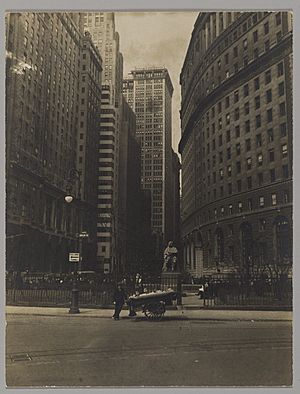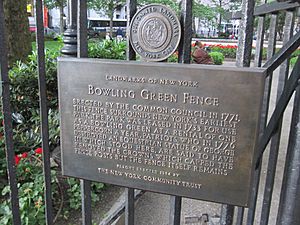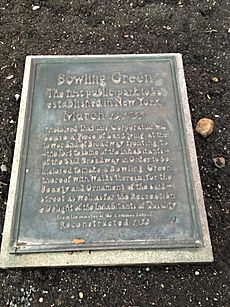Bowling Green (New York City) facts for kids
Quick facts for kids |
|
|
Bowling Green Fence and Park
|
|
|
U.S. Historic district
Contributing property |
|
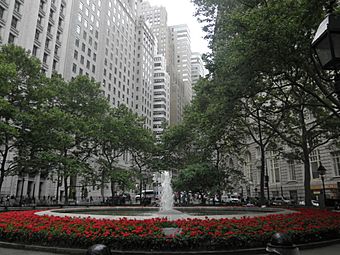
Bowling Green looking north from the fountain
|
|
| Location | Southern end of Broadway, Manhattan, New York |
|---|---|
| Built | 1733 |
| Part of | Wall Street Historic District (ID07000063) |
| NRHP reference No. | 80002673 |
| Added to NRHP | April 9, 1980 |
Bowling Green is a small public park in the Financial District of Lower Manhattan, New York City. You can find it at the very end of Broadway.
This park is special because it's the oldest public park in New York City. It was officially made a park in 1733. Before that, it was a public space near the first Dutch fort of New Amsterdam. The park is still surrounded by its original fence from the 1700s. Long ago, it had a real bowling green and a statue of King George III before the American Revolutionary War.
Many important buildings are around Bowling Green. These include the Alexander Hamilton U.S. Custom House and the Cunard Building. The famous Charging Bull sculpture is at the north end of the park. Battery Park is also nearby. Bowling Green is recognized as a historic place in the U.S. and is part of the Wall Street Historic District.
Contents
History
Colonial Era
Bowling Green has always been a busy spot. When New York was called New Amsterdam, it was a market for cows and a place for parades between 1638 and 1647. In 1675, the city's leaders said the area in front of the fort should be a yearly market. Two years later, in 1677, the city's first public well was dug here.
In 1733, the city rented part of this area to three important landowners. They paid a very small amount (like a "peppercorn" a year). In return, they promised to create a beautiful park for everyone to enjoy. This park was meant to have a "bowling green" and walking paths. The streets around it were paved with cobblestones in 1744.
On August 21, 1770, the British government put up a huge, gilded lead statue of King George III. It weighed about 4,000 pounds (1,800 kg). The King was shown in Roman clothes, like an old Roman emperor. This statue was meant to celebrate a British victory in a war.
However, relations with Britain quickly worsened. The statue became a target for protests. In 1773, a law was passed to stop people from damaging the monument. A strong cast-iron fence was built around the park to protect it. This fence is still there today, making it the oldest fence in New York City!
On July 9, 1776, a big event happened. The Declaration of Independence was read to Washington's soldiers. After that, a group called the Sons of Liberty rushed to Bowling Green. They pulled down the statue of King George III. During this, the decorative tops (finials) of the fence were sawn off. This moment is a famous part of New York City's history.
People say the statue was cut into pieces and sent to Connecticut. There, it was melted down to make over 42,000 bullets for the American soldiers. The King's head was supposedly paraded around town. However, some British supporters got it back and sent it to England. Today, a few pieces of the lead statue are kept in museums. This event has been shown in many paintings over the years.
On November 25, 1783, a U.S. soldier bravely took down the British flag at Bowling Green. He replaced it with the Stars and Stripes. The British had greased the flagpole to make it hard! As the British soldiers left New York, General George Washington led his Continental Army through Manhattan. They marched to Bowling Green to watch the last British troops sail away.
Post-Colonial Era
After the American Revolution, the old fort near Bowling Green was torn down in 1790. Some of its rubble was used to make Battery Park bigger. A grand building called Government House was built in its place. It was hoped this would be a home for the U.S. president. Later, Governor John Jay lived there.
When the state capital moved to Albany, the building became a boarding house. Then it was a customs house before being torn down in 1815. Fancy homes were built around the park. Important New York merchants and leaders lived in these brick houses. President George Washington even lived in one of these homes, the Alexander Macomb House, for a few months in 1790.
By 1825, Bowling Green Park was covered in grass. It was an oval shape, about 210 feet (64 meters) long and 140 feet (43 meters) wide. As more people moved north in Manhattan, the homes around the park became shipping offices. This meant the park became fully open to the public.
20th and 21st Centuries
In 1926, the park had paths, benches, and trees, but its lawns were not well kept. After World War II, the park was neglected. Starting in 1972, the city began to fix up Bowling Green. They wanted to make it look more like it did in the 17th century.
During this time, the Bowling Green subway station under the park was also expanded. This meant digging up parts of the park temporarily. The renovation faced money problems in the 1970s but was finished by the end of that decade.
In 1980, the Bowling Green Fence and Park were added to the U.S. National Register of Historic Places. In 1982, a plaque was placed in the park. It remembers a moment in 1707 when a religious leader, Francis Makemie, preached near the park. He was arrested for it but later found not guilty. This was an important step for religious freedom.
In 1989, the famous Charging Bull sculpture was placed at the north end of the park. Artist Arturo Di Modica created it. The city put it there after it was first placed illegally on Wall Street. The Charging Bull is now one of the most famous symbols of the Financial District.
In March 2017, Bowling Green was also named Evacuation Day Plaza. This name celebrates a key event in the American Revolutionary War. It marks the spot where British troops finally left New York after a seven-year occupation.
Description and Surroundings
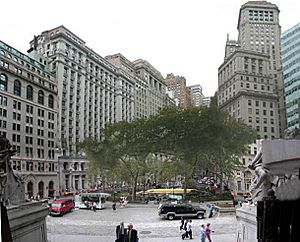
The park is shaped like a teardrop. It's where Broadway splits into two streets near Whitehall Street. Inside the fence, there's a grassy area with a large fountain in the middle. Benches around the park are popular spots for people working in the Financial District to eat lunch.
At the south end of the park is the Alexander Hamilton U.S. Custom House. This building now holds the National Museum of the American Indian. There used to be a street here, but it was removed to make space for a modern entrance to the subway station. The New York City Subway station, which opened in 1905, is located right under the park.
Many tall buildings surround the park. These include:
- The Alexander Hamilton U.S. Custom House
- The International Mercantile Marine Company Building at 1 Broadway
- The Bowling Green Offices Building at 11 Broadway
- The Cunard Building at 25 Broadway
- 26 Broadway, the old Standard Oil Company Building
- 2 Broadway, a modern glass building
Fence
The fence around Bowling Green Park was built in 1773. Its purpose was to protect the statue of King George III. It is still standing today and is the oldest fence in New York City. The fence was made of wrought iron on a stone base. Each post originally had decorative tops called finials, which once held lamps.
On July 9, 1776, the day the Declaration of Independence reached New York, the finials on the fence were sawn off. They were put back in 1786, but you can still see the saw marks today. In 1791, the fence and its stone base were made 2 feet (0.6 meters) taller.
The fence was moved to Central Park for a few years (1914-1919). This was done to make room for building the Bowling Green subway station. It was repaired again when the park was renovated in the 1970s. The fence was named an official city landmark in 1970.
Sculptures
The Charging Bull is a large bronze sculpture in Bowling Green. It weighs about 7,100 pounds (3,200 kg). It is 11 feet (3.4 meters) tall and 16 feet (4.9 meters) long. The sculpture shows a powerful bull leaning back, ready to charge. A bull is a symbol of strong financial growth and good times in the stock market. This sculpture is very popular with tourists and is a famous symbol of New York and Wall Street.
In 2017, another bronze sculpture called Fearless Girl was placed across from the bull. Sculptor Kristen Visbal created it. This statue was praised for its message about women's strength. It was put there to highlight the gender pay gap and the need for more women in leadership roles. The Fearless Girl statue shows a brave little girl standing defiantly and staring down the Charging Bull. The statue was later moved in November 2018 to face the New York Stock Exchange Building.
Images for kids
See also
 In Spanish: Bowling Green (parque) para niños
In Spanish: Bowling Green (parque) para niños





